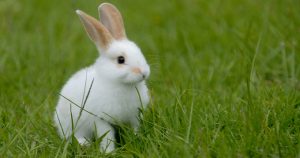Rabbits are social animals so should be kept with other rabbits for company.

Bucks & does should not live with each other unless they have been neutered otherwise you will soon have lots of baby rabbits to deal with! Whenever considering housing rabbits together, they should ideally be introduced to each other from an early age to help prevent fighting.
Hutches
Their accommodation should meet all your rabbit’s mental & physical needs. The hutch should be large enough for the rabbit to hop around adequately and provide mental stimulation to help prevent problems such as aggression and destructive behaviour.
The housing must include a suitable retreat where your rabbit can rest and escape from public view whenever they wish. An outdoor hutch needs to be sufficiently well made to provide dry, snug quarters all year round, particularly in wet or cold weather.
A hutch should be divided into two parts; one with a front made of wire mesh and the other with a solid wooden door to provide a sheltered retreat in bad weather. A dividing door between the day and sleeping quarters is also very useful and will allow you to clean out each section in turn, with the rabbit secure in the other part of the hutch. It is very important to choose a hutch that allows your rabbit to sit up without any difficulty. Many designs are suitable for guinea-pigs but too low for rabbits.
Ideally they should be 2ft off the ground to protect your rabbit from the cold and wet and to prevent them coming into contact with wild rabbits that could spread disease such as Myxomatosis and Rabbit Haemorrhagic Disease as well as internal and external parasites. The roof of the hutch should slope backwards to help rain run off quickly and should be protected with a waterproof covering. The hutch should be inspected for damage on a regular basis to avoid any injury or escapees!
Bedding
Bedding materials should consist of plenty of newspaper covered with an absorbent material such as wood shavings. These should be specifically designed for animal bedding to ensure that they have been dust extracted and had any sharp splinters removed to avoid eye injuries. Hay should also be provided for added warmth in the sheltered section of the hutch. Straw is not an ideal bedding material as it can cause sores on their feet due to the sharp ends.
Cleaning
Your rabbit’s hutch should be cleaned out at least on a weekly basis and more frequently in the summer months to help prevent flystrike. All their bedding should be removed and the hutch cleaned with a specialist hutch cleaner. It is important to ensure that you use the product at the right concentration as some disinfectants and cleaners are harmful to rabbits. It should be rinsed and dried thoroughly before fresh bedding is replaced. Any toys, drinking containers and food bowls should be cleaned daily and inspected for damage.
Outdoor Runs
 To provide your rabbit with the opportunity to exercise safely, you will also need to buy or make a suitable outdoor run. You can buy a ready made run easily from a pet shop but as with hutches, many runs sold are too low for rabbits. Rabbits naturally sit on their haunches and also sometimes stand up on their hind legs, so they will be happier if they are housed in a sufficiently tall run.
To provide your rabbit with the opportunity to exercise safely, you will also need to buy or make a suitable outdoor run. You can buy a ready made run easily from a pet shop but as with hutches, many runs sold are too low for rabbits. Rabbits naturally sit on their haunches and also sometimes stand up on their hind legs, so they will be happier if they are housed in a sufficiently tall run.
The run should be mobile to enable it to be moved onto fresh grazing on unsoiled grass. Make sure you check your rabbit’s grazing area for poisonous plants and weeds.
Another fact that needs to be considered is that rabbits burrow, so a run without a base section could be unsafe, especially if your rabbit likes to dig. It may also be possible for a fox to force their way in.
Cool, shaded areas should be provided as rabbits are susceptible to heat stroke and water bowls or bottles should be placed around the run and replenished daily or when empty.
If making your own run, a good size is 1.8m x 91cm x 91cm. For the frame a 2.5cm square timber should be adequate but ensure that when you treat the timber you use a non toxic preservative. When trimming the edges of the mesh avoid leaving sharp ends that could cause injury to your rabbit.
The roof section should be bolted to the rest of the run so that it is secure but also easily removable to remove the rabbit safely. For protection from the rain & sun you could cover one end and its adjacent sides and roof with weather boarding.




